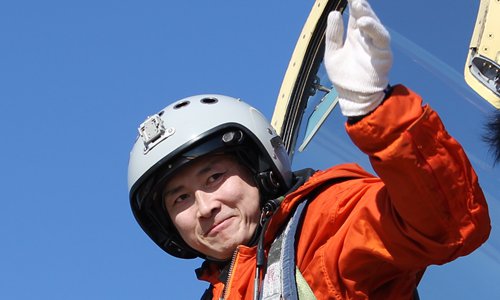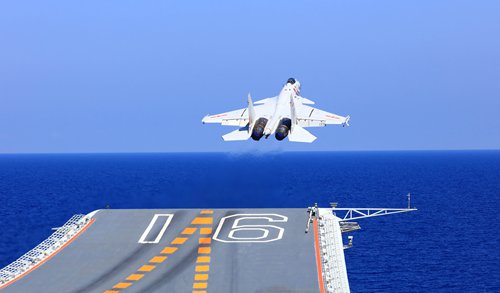Here is the account of Dia Mingmeng the first pilot landed on the deck of carrier a historic moment for China Now some people in this forum try to discount the achievement by saying China get help from Brazil No such thing according to Dai Mingmeng They have to write their own text. The success can be attributed to nothing but hard work
For his effort he is credited with honor as 100 people who advanced the cause of reform recently
China’s first carrier-borne fighter jet pilot dedicated to training pilot teams
By Global Times - Agencies Source:Global Times Published: 2019/1/3 18:45:18
Dai Mingmeng Photo: VCG
It was a dream from childhood to fly into the blue sky for Dai Mingmeng, who became the first Chinese pilot to successfully land on and take off from China's first aircraft carrier, in a J-15 fighter jet in 2012.
Two months after China commissioned the
Liaoning carrier in September 2012, Dai landed a J-15 on the carrier's flight deck, the first Chinese pilot to achieve the feat. And he then began training carrier-based fighter jet commanders and drillmasters.
On December 18, Dai was selected as one of the 100 representatives who made great contributions to China's reform and opening-up.
Moving toward glory
Recalling what happened on November 23, Dai said that he was calm as usual and came to the control tower early to make preparations for flying. "No one talked to me. The atmosphere was heavier than usual," Dai said.
"I never doubt myself. Before the first landing, we flew around the Liaoning more than 500 times and touched the deck of the aircraft carrier during the flight dozens of times. When the fighter jet took off, I waved to others," Dai said.
Around 9 am, Dai's fighter came near the aircraft carrier with roar. The jet took the first turn and another turn, and put down the undercarriage and the arresting hook. When the jet's back wheel touched the deck, its arresting hook firmly caught the arresting gears installed on the deck. The fighter jet stopped.
"We succeeded!" shouted the people who waited on the deck, with tears of joy.
Sun Cong, the chief designer of the J-15, hugged Dai once he got out of the jet. Others queued to give him a hug.
In an article published in the People's Liberation Army (PLA) Daily in October 2018, Dai wrote, "That was the most unforgettable day in my life… We achieved a dream that the Chinese have dreamed for a hundred years. Every time I recall the moment of realizing the dream, I am filled with passion and enthusiasm."
A J-15 takes off from the Liaoning. Photo: VCG
Seeking the way
The glorious moment did not come from nothing. It was built on the sweat and efforts of many pilots.
Song Zhongping, a military expert and TV commentator, told the Global Times that the work of pilots of fighter jets on aircraft carriers is very dangerous. "It's like dancing on the edge of the knife. A minor error would cost the life of a pilot. And China's first group of pilots of this kind managed to overcome these difficulties without any assistance."
Song said that China's first pilots for fighter jets of aircraft carriers were selected from the PLA Navy and PLA Air Force. "They were trained to be pilots by flying from the land. Many skills of operating the fighter jets for aircraft carriers are different, sometimes even opposite, to what they had learned previously, which makes it more difficult to train these pilots."
Dai was trained in a PLA Air Force flight academy in Baoding, North China's Hebei Province and was deployed to the PLA Navy to fly fighter jets. He operated 16 kinds of fighter jets, dealt with dozens of extremely dangerous situations and twice escaped from the door of death.
While Dai was flying fighter jets for the PLA Navy, China started to realize its aircraft carrier dream step by step. It brought the aircraft carrier
Varyag from Ukraine in 1998. The carrier was rebuilt for the PLA Navy as the
Liaoning.
In September 2006, the PLA Navy began to select fighter jet pilots for the aircraft carrier. Dai was among the first group of pilots.
Without experience, available teaching materials or assistance from other countries, Dai and other pilots began to prepare for flying and landing fighter jets from the aircraft carrier.
"It's like learning a course without a teacher, and we were required to give a perfect performance," Dai said.
The runway on the aircraft carrier is about one-tenth the length of one on land. In addition, the carrier is in motion.
Dai's first try to catch the arresting gear was attempted on an experimental site on land. Dai put down the arresting hook and caught the arresting gear. The speed of the jet decreased from 200 kilometers per hour to zero within 2 seconds.
He felt the blood of his whole body rush into his head - it was like a sudden stop during a sprint. After a moment of memory loss, Dai found his jet stopped safe and sound.
Before the successful landing on November 23, 2012, Dai underwent more than 400 test flights and flew around the aircraft carrier 100 times.
After Dai, another four pilots successfully took off and landed on the
Liaoning. The PLA Navy entered into the aircraft carrier era.
For the nation
Dai was honored as a "hero fighter jet pilot for aircraft carriers" in August 2014. But he did not rest on this glory.
"When can China train its own fighter jets pilots in quantity and quality?" Dai has continually asked himself this question, because a group of experienced fighter jet pilots is necessary for the aircraft to have combat capability.
A pilot group was founded under the guidance of Dai. The group is working on writing textbooks, making teaching courses and curriculum and organizing practice. By operating the fighter jet himself, Dai shows flying skills to students, and analyzes and comments on students' performances.
In December 2016, boarding the Liaoning, Dai led a group of young fighter jet pilots to the aircraft carrier to undergo combat drills in foreign waters.
"In the waters of Bohai, the Yellow Sea, the East China Sea and the South China Sea, we underwent combat drills and tested the command process and the capability of the aircraft fleet, which also marks the transformation of the PLA Navy," Dai said.
With the efforts of Dai and other pilots, China has become one of the few countries that could independently train pilots for the aircraft carrier.
"There are three things in a pilot's mind - the blue sky, the mission and our motherland. When I operate a fighter jet in the blue sky, I feel my life is closely connected with my mission and my country. I am embraced by happiness. I thank my country, which is getting powerful and making our fleet moving forward," Dai wrote in the article in the PLA Daily.
Newspaper headline: Taking off


